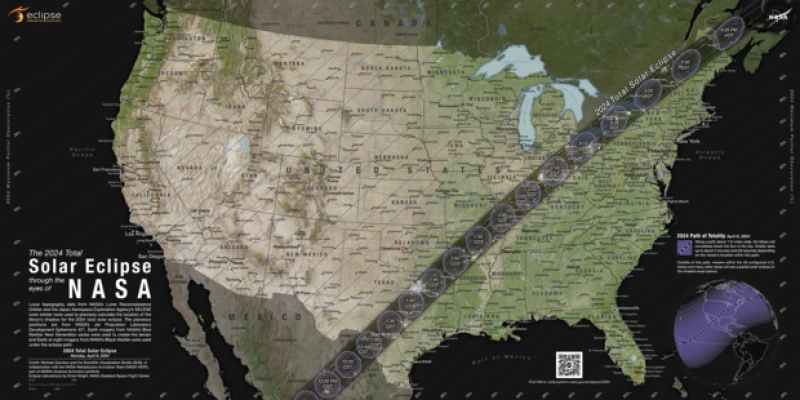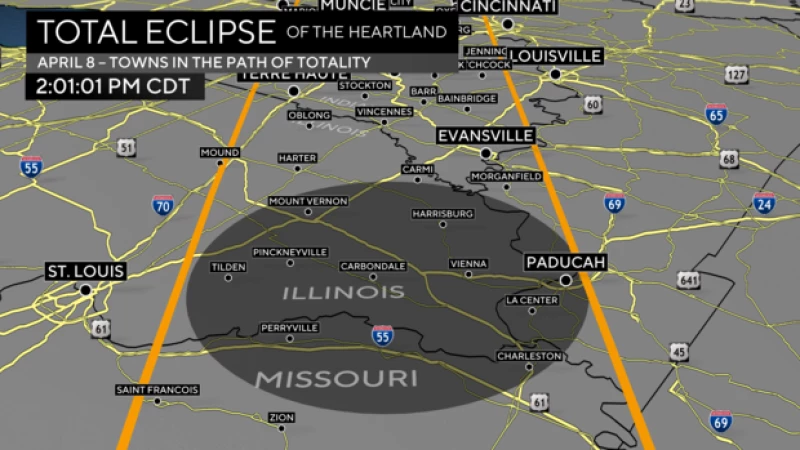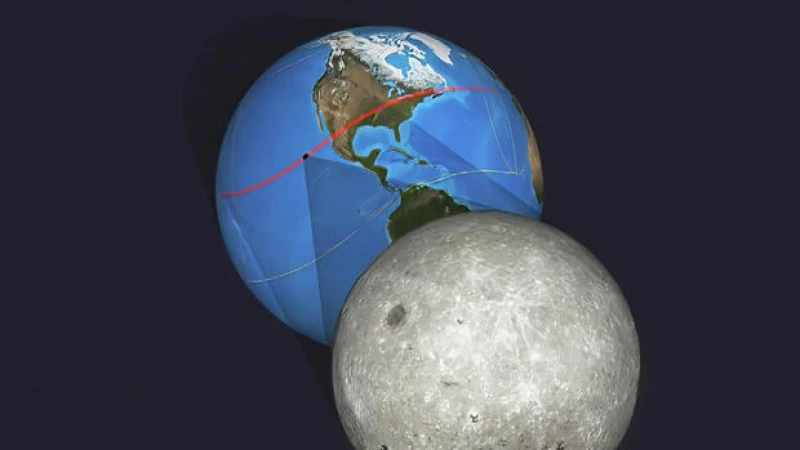America is gearing up for the April 8 total solar eclipse, and many are checking maps to find the best location to watch within the path of totality. But those hoping to view the corona and see a fully darkened midday sky might find themselves dodging clouds due to April weather patterns.
The last time a total solar eclipse traversed an elongated path across the continental U.S. — on Aug. 21, 2017 — Americans could be caught gazing at the midday dark from Oregon all the way to South Carolina. Most spots along the path of totality enjoyed reasonably clear, summer skies.
Those living or visiting along the path of totality next week may not end up so fortunate, as historical weather maps show the odds of experiencing a cloud-free sky at this time of year are somewhat less than ideal. In fact, finding a totally clear view at any given time is closer to the exception than the rule.
"According to NASA, at any given time, 70% of the earth is covered in clouds," said Mike Augustyniak, CBS Minnesota director of meteorology.
Not only is North America in the middle of the volatility of changing seasons during this year's solar event, but meteorologists note that we're also currently in an El Niño pattern, albeit one that's proven quieter than usual.
"An El Niño pattern tends to increase the chances of cloudy, rainy weather in those areas. Interestingly, though, that is not how this winter and spring have played out," said Augustyniak. "Since the start of 2024, Texas Hill Country and western Texas areas have been markedly drier than average; if that trend holds for the next few weeks, that would be good news for eclipse watchers."
The path of totality is only about 150 miles wide, and in America stretches roughly 2,500 miles from the Texas border to the last few towns in northeastern Maine. That leaves only so many places where you can seek the full show, though the path's width will be significantly wider than it was in 2017, according to NASA, as the moon will to be closer to Earth on this pass than it was then.
So will April showers bring spectator flowers? Here's a breakdown of which places along the path of totality are most likely to give eclipse chasers the best odds.
Viewing the eclipse in Texas, Oklahoma and Arkansas
Augustyniak said at this transitional time of year, the further south you can go, the more likely you are to experience clear skies during eclipse totality.
"The upcoming total eclipse on April 8 will be visible in various regions, including the Hill Country of Texas, and the Mexican states of Coahuila and Durango," mentioned Augustyniak.
However, as you move further south, the likelihood of encountering clouds and rain increases.
"Spring is typically our storm season," noted Jeff Ray, the chief meteorologist for CBS Texas.
Ray advised that individuals might need to engage in some reverse storm-chasing during the eclipse, meaning they may have to quickly navigate away from approaching clouds instead of towards them, especially in Texas, Arkansas, and Oklahoma.
"There are expected storms around April 8. This is because it's common to have multiple rounds of storms during the spring season in our region. The long-range GFS model indicates storms on the eighth," mentioned Ray, adding a disclaimer. "However, long-range models are not always precise for a specific day. Yet, there is a high probability that the forecasted storms will occur, give or take a 36-hour window."
Ray provided insights on the weather conditions in Texas during April, highlighting that the state experiences sunny or mostly sunny days only around 28% of the time. On the other hand, mostly cloudy or fully overcast days occur about 36% of the time.
According to Ray, high clouds often precede storm systems, appearing overhead in April approximately 22% of the time. He mentioned that a sky with some cloud cover is typical, with mornings tending to be near overcast and afternoons clearing up for more sunshine, making the odds of a good view of the eclipse higher.
The total solar eclipse is expected to occur in Texas between 1:30 p.m. CT near Elm Creek and concluding near the Oklahoma border just before 2 p.m. Some of the most densely populated areas along the eclipse path include San Antonio, Austin, and Dallas-Fort Worth.
Additionally, Ray advised considering tornadoes if traveling to the region, noting that north Texas has witnessed over 1,100 tornadoes in April and May since 1880, compared to nearly 900 in all other months combined. He emphasized the significant variability in tornado counts from year to year within the 61-day period.
Ultimately, Ray said that April is traditionally the third-stormiest month of the year in Texas.
"In short, April is not the best, nor the worst) time of the year to hope for clear or mostly clear skies. The best would be July or August. The worst would January or February," he said. "We get a decent idea of the expected weather about seven days out. Four days out we get more comfortable talking about the timing of a rain or storm event. But it's the weather, we are trying to throw a lasso around chaos. It is not rare we forecasters look like fools."
Viewing the eclipse in Missouri, southern Illinois and Indiana
While many are likely to head as far south as possible, some of the biggest cities in the Midwest are likely to fuel day-of migration to spots in Missouri and Illinois, many of them likely seeing a total eclipse for the second time in a decade. A small zone centered around Carbondale, Illinois, was along the path of totality in 2017, and will be once again this month.
For those in the St. Louis area looking for prime spots to watch the eclipse in southeastern Missouri, historical data suggests that the chances of having a clear view are similar to those in Arkansas. As for individuals in the Chicago metro area, heading south toward Illinois may offer the best opportunity for optimal viewing.
"If traveling to Texas or Arkansas is not an option, then Southern Illinois and Indiana provide the best chance for a cloud-free sky, based on a 43-year average and, of course, weather conditions," noted Albert Ramon, chief meteorologist for CBS Chicago.

While some may be satisfied with 90% or 95% totality, Ramon cautions that residents of the Chicago metro area might face a higher risk of having their view obstructed by clouds.
"Based on a comprehensive 43-year average, April 8 typically sees cloud cover chances ranging from 60 to 80% in Chicago and its neighboring suburbs, with similar trends in Indianapolis, where cloud cover varies between 60 to 70%," Ramon explained.
Observing the eclipse near the Great Lakes and Pennsylvania
Ramon also pointed out that another factor that could complicate eclipse viewing along the path of totality in the Midwest is the lingering impact of an El Niño weather pattern.
"The presence of El Niño increases the likelihood of cloud cover across the Midwest and Great Lakes regions," Ramon added. "This year, we may experience even cloudier conditions than usual."
The Great Lakes portion of totality's path includes large sections of Ohio, including Cleveland, along with the area of Ontario south of Toronto, Niagara Falls, and Erie, Pennsylvania. CBS Pittsburgh meteorologist Ray Petelin said many of these areas are subject to the wildcard that is the Great Lakes.
"They are known for lake-effect snow, but it is the lake-effect clouds that could hide the eclipse. Erie, which is in the path of totality, averages only six clear days during the month of April. Pittsburgh, which has the potential to see around 97% of totality, only averages four clear days in April," Petelin said.

Petelin says that a southerly breeze and warmer-than-average temperatures would go a long way toward helping the Great Lakes region out on April 8.
"While the historical data suggests the chances for a clear day are low, this winter and early spring have been exceptionally bright and warmer than usual. Let's keep our fingers crossed that we can get that perfect weather for when it matters most," Petelin said.
As it stands, the areas near the shores of the Great Lakes historically show a higher probability for clearer skies than areas inland.
Viewing the eclipse in New England
The eclipse will wrap up its march across the U.S. when the path of totality cuts across state lines from New York to Vermont just before 3:30 p.m. ET. By this point in the event, the duration of totality along the central line will have already fallen off from its peak — about 4 minutes, 30 seconds near Nazas, Mexico — to just over 3 minutes, 30 seconds, according to NASA.

"The southern edge of the totality line passes right through the towns of Middlebury, Northfield and Barre. You will need to get just north of these areas. Some suggested 'larger' towns include Montpelier, St. Johnsbury, Newport and Burlington," said Terry Eliasen, executive weather producer for CBS Boston.
In New Hampshire, the southern edge of totality will pass just north of the White Mountains. And in Maine, you'll need to get north of major cities like Portland, Augusta and Bangor. Eliasen said the entirety of Baxter State Park will be in the totality path, including Mount Katahdin.
The bad news: Eliasen said that those in the New England area face possibly the stiffest odds in the country for catching clear skies next Monday, based on historical patterns. The data says you're more likely to be negatively impacted by clouds pretty much anywhere in these three states than not.
"Frankly, northern New England is probably the worst place (historically speaking) in the path of totality as far as cloud cover goes," said Eliasen. "Of course, we could get lucky."
No luck? There's always the 2045 total solar eclipse
For those who remain hopeful despite their current location, there is one last resort that may provide a glimmer of hope, courtesy of a celestial event.
"As totality approaches and sunlight diminishes, temperatures are expected to drop significantly. The cooler temperatures can help stabilize the atmosphere, similar to a sunset after a hot summer day, potentially reducing cloud cover," explained a meteorologist. "However, the ideal scenario is to find a cloud-free area from the start."
If clouds obstruct the view during the upcoming event, there is another opportunity in August 2045, when a path of totality will extend from northern California to Miami Beach. It's worth noting that this occurrence will coincide with the peak of hurricane season.







